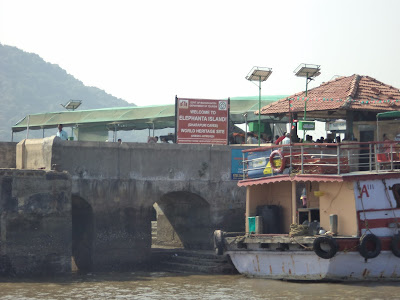FROM the eyes of DR AJAY KUMAR OJHA :
GHARAPURI OR ELEPHANTA ISLAND
(UNESCO World Heritage Site)
(All the images are subject to IPR)
 |
Hotel Taj & Gateway Of India
Photo(c) Dr Ajay Kumar Ojha |
 |
| Photo (c) Dr Ajay Kumar Ojha |
 |
| Photo (c) Dr Ajay Kumar Ojha |
 |
| Photo (c) Dr Ajay Kumar Ojha |
 |
| Photo (c) Dr Ajay Kumar Ojha |
The Elephanta Caves are a network of sculpted caves located on Elephanta Island, or Gharapuri(literally "the city of caves") in Mumbai Harbour, 10 kilometres to the east of the city of Mumbai in the Indian state of Maharashtra. The island, located on an arm of the Arabian Sea, consists of two groups of caves—the first is a large group of five Hindu caves, the second, a smaller group of two Buddhist caves. The Hindu caves contain rock cut stone sculptures, representing the Shaiva Hindu sect, dedicated to the god Shiva.
 |
Photo (c) Dr Ajay Kumar Ojha
|
 |
Gharapuri Island in background
Photo(c) Dr Ajay Kumar Ojha
|
 |
| Photo (c) Dr Ajay Kumar Ojha |
 |
Toy Train for Gharapuri Island
Photo (c) Dr Ajay Kumar Ojha |
The rock cut architecture of the caves has been dated to between the 5th and 8th centuries, although the identity of the original builders is still a subject of debate. The caves are hewn from solid basalt rock. All the caves were also originally painted in the past, but now only traces remain.
 |
Photo (c) Dr Ajay Kumar Ojha
|
 |
Photo (c) Dr Ajay Kumar Ojha
|
 |
Photo (c) Dr Ajay Kumar Ojha
|
 |
| Photo (c) Dr Ajay Kumar Ojha |
The island was called Gharapuri and was a Hindu place of worship until Portuguese rule began in 1534. The Portuguese called the island Elephanta on seeing its huge gigantic statue of an Elephant at the entrance. The Statue is now placed in the garden outside the Bhau Daji Lad Museum at the Jijamata Udyaan at Byculla in Mumbai. This cave was renovated in the 1970s after years of neglect, and was designated a UNESCO World Heritage Site in 1987 to preserve the artwork.
 |
An Unfinished Buddhist Cave
Photo (c) Dr Ajay Kumar Ojha |
The island covers about 4 square miles at high tide and about 6 square miles at low tide. Gharapuri is small village on the south side of the island. The Elephanta Caves can be reached by a ferry from the
Gateway of India,
Mumbai, which has the nearest airport and train station..
 |
Photo (c) Dr Ajay Kumar Ojha
|
 |
| Photo (c) Dr Ajay Kumar Ojha |
Portuguese rule saw a decline in the Hindu population on the island and the abandonment of the Shiva cave (main cave) as a regular Hindu place of worship, though worship on
Mahashivratri, the festival of Shiva, continued and still does.
 |
| Photo (c) Dr Ajay Kumar Ojha |
The Portuguese did considerable damage to the sanctuaries. Portuguese soldiers used the reliefs of Shiva in the main cave for target practice, sparing only the Trimurti sculpture. They also removed an inscription related to the creation of the caves. While some historians solely blame the Portuguese for the destruction of the caves, others also cite water-logging and dripping rainwater as additional damaging factors. The Portuguese left in 1661.